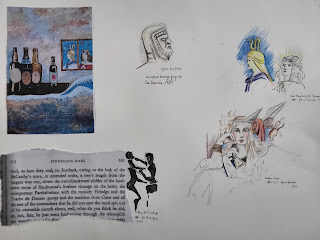
In the quest to explore the life and legends surrounding St.
Brendan the Navigator and his connections with Galway and Clonfert, it is
crucial to recognise the profound impact that visiting these sites can have on
one's understanding. Just as I embarked on an expedition to Clonfert during my
search for inspiration for the Galway Project, I realised the importance of first-hand
experience in grasping the history and significance of these locations. I had
seen photos of the Romanesque doorway and stonework adorning the small
cathedral, and I knew that St. Brendan's grave rested there. However, it became
clear that to truly connect with the history and spirituality of these places,
one must stand on the same ground, breathe in the atmosphere, and witness the
tangible relics of the past. In my journey to Clonfert, I aimed to find not
only the physical remnants but also the essence of St. Brendan, just as James
Joyce sought to uncover the multifaceted symbolism and timeless themes associated
with this revered Irish figure in his masterpiece, "Finnegans Wake."
St. Brendan the Navigator, also known as St. Brendan of
Clonfert, was a legendary Irish saint whose life and adventures have captured
the imagination of people for centuries. He is revered not only for his
religious contributions but also for his remarkable journeys across the sea.
St. Brendan, born in the year 484 AD in the Kingdom of
Munster, Ireland, was destined for a life of devotion to the Christian faith.
He entered the monastic life and eventually founded a monastery at Ardfert in
County Kerry. However, it is his remarkable voyages that have made him famous
worldwide. St. Brendan is often referred to as "the Navigator" because
of his legendary voyage to the "Isle of the Blessed" or "Saint
Brendan's Island." This journey, recounted in the "Navigatio Sancti
Brendani" or "The Voyage of St. Brendan," is one of the earliest
and most celebrated travel narratives in European history.
“And all the Dunders de Dunnes in Markland's Vineland beyond
Brendan's herring pool takes number nine in yangsee's hats.” FW. 213.35
St. Brendan's connection with Galway lies in his voyage from
Ireland, which is said to have started from the Galway Bay area. According to
legend, in the 6th century, St. Brendan embarked on a seven-year journey across
the Atlantic Ocean in a small boat made of animal skins and wood. His voyage
was not only a religious pilgrimage but also an exploration of the unknown.
During this journey, he and his companions encountered many fantastical
creatures, including sea monsters, birds that sang psalms, and islands that
moved.
One of the most famous episodes from St. Brendan's voyage is
the encounter with a giant fish. It is said that St. Brendan and his fellow
monks mistook the fish for an island, anchored their boat, and lit a fire. When
the fish awoke, it submerged, nearly taking the monks with it. This story has
often been interpreted as a symbolic representation of the challenges and
trials faced by the early Christian explorers.
While the historical accuracy of St. Brendan's voyage is
debated, there is evidence that his story had a significant impact on the
exploration of the Atlantic. Some argue that his journey may have contributed
to later European exploration efforts, such as Christopher Columbus' voyages to
the Americas.
Another notable connection between St. Brendan and Galway is
the historic Clonfert Cathedral. Clonfert, also known as Clonfert-Mulloe, is a
small village in County Galway. It was here that St. Brendan founded a
monastery and became the bishop. Clonfert Cathedral, also known as St. Brendan's
Cathedral, is a testament to his influence in the region. The cathedral,
although much altered over the centuries, still contains elements of its
original construction dating back to the 12th century.
St. Brendan's association with Clonfert and the establishment
of a Christian community in the area played a crucial role in the spread of
Christianity throughout Ireland. His legacy is further preserved in the
"Brendan Cross," a stone cross dating to the 9th or 10th century,
which stands near the cathedral.
Navigating the Waters of Consciousness: Much like St.
Brendan navigated the physical waters of the Atlantic, the characters in
"Finnegans Wake" navigate the vast and often turbulent waters of
consciousness. St. Brendan's voyages become a metaphor for the human quest for
self-discovery and understanding.
The Wake as an Epic Journey: The structure of
"Finnegans Wake" itself can be seen as a kind of epic journey, with
the novel looping back on itself, just as Brendan's voyages are said to be
cyclical. The circular and nonlinear narrative mirrors the cyclical nature of
history, myth, and human experience.
In "Finnegans Wake," St. Brendan serves as a
multifaceted symbol, representing themes of exploration, pilgrimage, cyclical
time, and the interplay between tradition and modernity. Joyce's use of
allusion and wordplay makes references to St. Brendan just one layer of the
complex narrative, inviting readers to dive into the depths of his work and
explore the myriad connections and interpretations that can be drawn from it. The
structure of "Finnegans Wake" itself can be seen as a kind of epic
journey, with the novel looping back on itself, just as Brendan's voyages are
said to be cyclical. The circular and nonlinear narrative mirrors the cyclical
nature of history, myth, and human experience.
In conclusion, St. Brendan the Navigator is a legendary
figure in Irish history and Christian tradition. His connection with Galway is
rooted in the legends of his epic voyage, which is said to have started from
the Galway Bay area. Additionally, his association with the monastery of
Clonfert in County Galway underscores his significant contributions to the
spread of Christianity in Ireland. St. Brendan's legacy continues to inspire
those interested in both religious history and the adventurous spirit of exploration,
making him a revered figure not only in Ireland but also in the broader context
of world history.

















.jpg)

